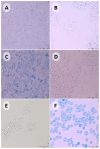Yeast Diversity on Sandy Lake Beaches Used for Recreation in Olsztyn, Poland
- PMID: 40872254
- PMCID: PMC12389204
- DOI: 10.3390/pathogens14080744
Yeast Diversity on Sandy Lake Beaches Used for Recreation in Olsztyn, Poland
Abstract
Yeasts possess a range of environmental adaptations that allow them to colonize soil and sand. They can circulate seasonally between different components of lake ecosystems, including beach sand, water, and the coastal phyllosphere. The accumulation of people on beaches promotes the development and transmission of yeasts, posing an increasing sanitary and epidemiological risk. The aim of this study was to determine the species and quantitative composition of potentially pathogenic and pathogenic yeasts for humans present in the sand of supervised and unsupervised beaches along the shores of lakes in the city of Olsztyn (northeastern Poland). The study material consisted of sand samples collected during two summer seasons (2019; 2020) from 12 research sites on sandy beaches of four lakes located within the administrative boundaries of Olsztyn. Standard isolation and identification methods used in diagnostic mycological laboratories were applied and are described in detail in the following sections of this study. A total of 259 yeast isolates (264, counting species in two-species isolates separately) belonging to 62 species representing 47 genera were obtained during the study. Among all the isolates, five were identified as mixed (two species from a single colony). Eight isolated species were classified into biosafety level 2 (BSL-2) and risk group 2 (RG-2). The highest average number of viable yeast cells was found in sand samples collected in July 2019 (5.56 × 102 CFU/g), August, and September 2020 (1.03 × 103 CFU/g and 1.94 × 103 CFU/g, respectively). The lowest concentrations were in samples collected in April, September, and October 2019, and October 2020 (1.48 × 102 CFU/g, 1.47 × 102 CFU/g, 1.40 × 102 CFU/g, and 1.40 × 102 CFU/g, respectively). The results indicate sand contamination with yeasts that may pose etiological factors for human mycoses. In light of these findings, continuous sanitary-epidemiological monitoring of beach sand and further studies on its mycological cleanliness are warranted, along with actions leading to appropriate legal regulations.
Keywords: beaches; lake ecosystems; microfungi; sand; sand pollution; yeasts.
Conflict of interest statement
The authors declare no conflicts of interest.
Figures




References
-
- World Health Organization (WHO) Guidelines for Recreational Water Quality. World Health Organization; Geneva, Switzerland: 2021. [(accessed on 15 May 2025)]. Available online: https://www.who.int/publications/i/item/9789240031302.
-
- Krajewska-Kułak E., Łukaszuk C., Gniadek A., Macura A.B., van Damme-Ostapowicz K., Lewko J., Rolka H., Rozwadowska E., Guzowski A. Zanieczyszczenie Powietrza w Pomieszczeniach Mieszkalnych, Ze Szczególnym Uwzglednieniem Roli Grzybów [Air Pollution in Aviation Air, with Detailed Consideration of the Role of Fungi] Mikol. Lek. 2010;17:177–181.
-
- Ejdys E., Dynowska M., Biedunkiewicz A., Sucharzewska E. An Overview of the Species of Fungi Occurring in School Rooms—A Four-Year Study. Pol. J. Environ. Stud. 2013;22:1691–1700.
-
- Wrzosek M., Ruszkiewicz-Michalska M., Sikora K., Damszel M., Sierota Z. The Plasticity of Fungal Interactions. Mycol. Prog. 2017;16:101–108. doi: 10.1007/s11557-016-1257-x. - DOI
MeSH terms
Substances
Grants and funding
LinkOut - more resources
Full Text Sources
Miscellaneous

